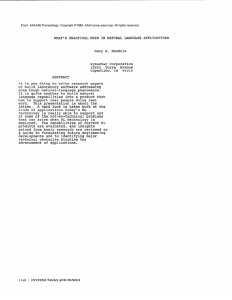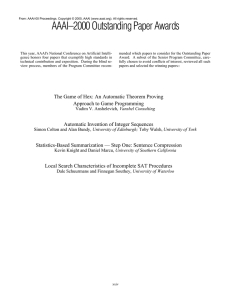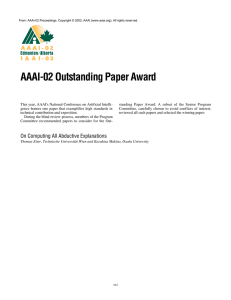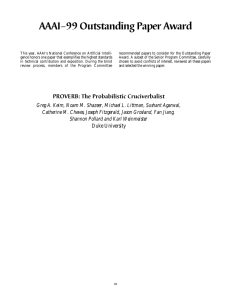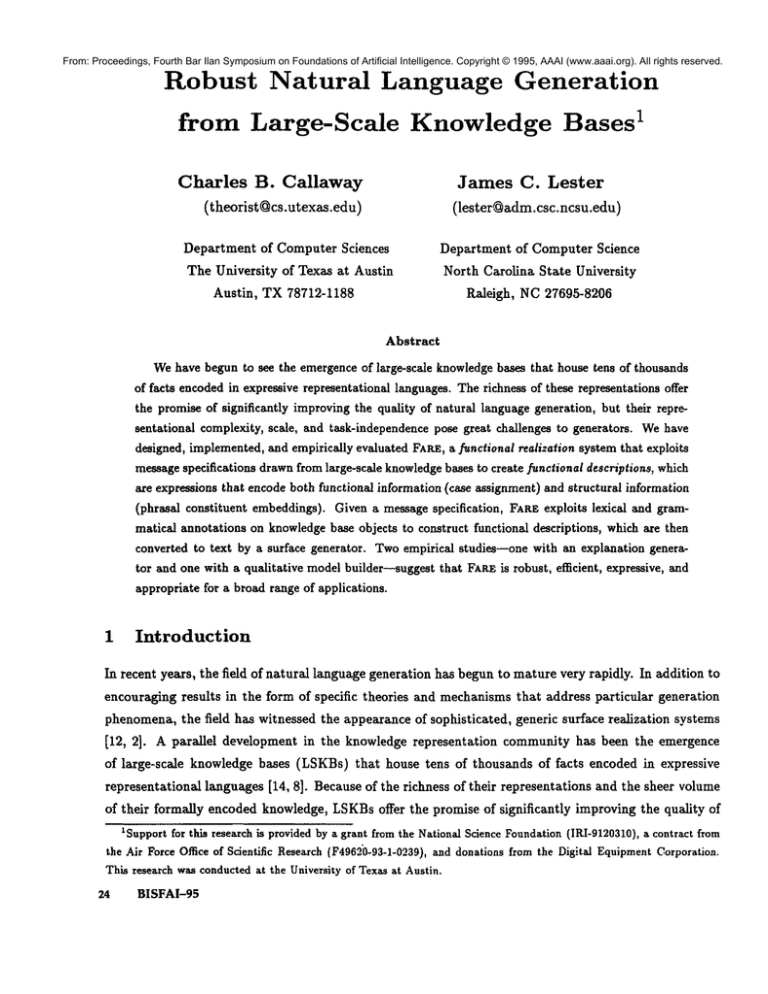
From: Proceedings, Fourth Bar Ilan Symposium on Foundations of Artificial Intelligence. Copyright © 1995, AAAI (www.aaai.org). All rights reserved.
Robust
Natural
Language
1from Large-Scale
Generation
Knowledge
Charles B. Callaway
Bases
James C. Lester
(lester~adm.csc.ncsu.edu)
(theori
st@cs.
utexas,
edu
Department
of ComputerSciences
Department of Computer Science
of Texasat Austin
The University
North Carolina State University
Austin,TX 78712-1188
Raleigh,
NC 27695-8206
Abstract
Wehavebegun
toseetheemergence
oflarge-scale
knowledge
bases
thathouse
tensof thousands
offacts
encoded
inexpressive
representational
languages.
Therichness
ofthese
representations
offer
thepromise
ofsignificantly
improving
thequality
ofnatural
language
generation,
buttheir
representational
complexity,
scale,
andtask-independence
posegreat
challenges
togenerators.
Wehave
designed, implemented,and empirically evaluated FARE, a functional realization systemthat exploits
messagespecifications drawnfrom large-scale knowledgebases to create functional descriptions, which
are expressions that encodeboth functional information(case assignment)and structural information
(phrasal constituent embeddings).Given a messagespecification, FAREexploits lexical and grammatical annotations on knowledgebase objects to construct functional descriptions, whichare then
converted to text by a surface generator. Twoempirical studies--one with an explanation generator and one with a qualitative modelbuilder--suggest that FARE
is robust, efficient, expressive, and
appropriate for a broad range of applications.
1
Introduction
In recent years, the field of natural language generation has begunto mature very rapidly. In addition to
encouraging results in the form of specific theories and mechanismsthat address particular generation
phenomena,the field has witnessed the appearance of sophisticated, generic surface realization systems
[12, 2]. A parallel
of large-scale
development in the knowledge representation
community has been the emergence
knowledge bases (LSKBs)that house tens of thousands of facts encoded in expressive
representational languages [14, 8]. Because of the richness of their representations and the sheer volume
of their formally encoded knowledge, LSKBsoffer the promise of significantly
improving the quality of
XSupport
for this research is providedby a grant fromthe NationalScienceFoundation(IRI-9120310),
a contract from
the Air ForceOffice of Scientific Research{F4962’0-93-1-0239),
anddonationsfromthe Digital Equipment
Corporation.
This research wasconductedat the Universityof Texasat Austin.
24
BISFAI-95
From: Proceedings, Fourth Bar Ilan Symposium on Foundations of Artificial Intelligence. Copyright © 1995, AAAI (www.aaai.org). All rights reserved.
natural language generation. However, the representational
complexity, scale, and task-independence
of LSKBspose great challenges to natural language generators.
The objective of our research is to develop techniques for expressive, robust natural language generation that can take advantage of these developments in surface realization and large-scale knowledge
2base construction. To this end, we have designed, implemented, and empirically evaluated FARE,
a functional realization system that exploits message specifications
drawn from large-scale knowledge
bases to create functional descriptions [2, 3], whichare expressions that encode both functional information (case assignments) and structural
specification,
information (phrasal constituent embeddings). Given a message
FAREconstructs functional descriptions,
which are then converted to text by the FuF
surface generator [2, 3]. Wehave conducted these investigations
in the "laboratory" provided by the
Biology KnowledgeBase Project. The result of a seven year effort, the Biology KnowledgeBase [14] is
an immense, task-independent representation
of more than 180,000 facts about botanical anatomy and
physiology. To study FARE’srobustness and range of applicability,
it was evaluated with two very dif-
ferent text planners: an explanation generator, KNIGHT
[10, 11, 9], and a qualitative model constructor
TRIPEL[15], which was augmented to produce text plans.
2
Functional
Realization
Classically,
natural
language
generation
hasbeendecomposed
intotwosubtasks:
planning,
determining
thecontent
andorganization
of a text,andrealization,
translating
thecontent
to natural
language.
Realization
canbe decomposed
intotwosubtasks:
functional
realization,
constructing
functional
descriptionsfrommessage
specifications
supplied
by a planner;
andsurface
generation,
translating
functional
descriptions
to text.Ourworkfocuses
on thedesign
andimplementation
of functional
realizers,
which
translate
message
specifications
intofunctional
descriptions
thatencode
caseassignments
andphrasal
constituent
embeddings.
Figure
1 depicts
a sample
functional
description
(FD).Thefirstline,(catclause),
indicates
whatfollowswillbe sometypeof verbalphrase.
Thesecondlinecontains
thekeyword
proc,which
denotes
thateverything
in itsscopewilldescribe
thestructure
of theverbal
phrase.
Thenextstructure
comesundertheheading
partic;
thisis wherethethematic
rolesof theclause
arespecified.
In this
instance,
onethematic
roleexists
in themainsentence,
theagent,whichis further
defined
by its
lexical entry and a modifying prepositional phrase indicated by the keyword qua3.£f£er. The structure
beginning with circum describes a subordinate infinitival
A functional realizer
purpose clause.
must create a mapping between the content units in a message specification
and the constituents and semantic roles in functional descriptions.
To properly realize the frames and
2Functional
AssignerofRoleEmbeddings.
Callaway
2S
From: Proceedings, Fourth Bar Ilan Symposium on Foundations of Artificial Intelligence. Copyright © 1995, AAAI (www.aaai.org). All rights reserved.
((cat
clause)
(proc ((type
(partic
material)
((agent
(lex
’’reproduce")))
((cat common) (lex ’’spore’’)
(qualifier
((cat pp) (prep === ’’from’’)
(np ((cat
(lex
common)
’’cell’’)
(classifier
((cat
noun-compound)
(classifier
=== ’’msgaspor@’’)
(head wl= ’’mother,~)))
(qualifier
((cat
pp) (prep===
’’in’’)
(np ((cat common)
(lex ’’eporaneium’’)))))))))))))
(circum ((purpose
((cat
clause)
(position
end) (keep-for
(proc ((type material) (lex
(partic ((agent ((semantics
(affected
((cat
(time-relater
=ffi=
’’during
’’form’’)))
{partic agent semantics})))
common) (lex
(classifier
no) (keep-in-order
---
’’gamete")
’’plant’’)
(cardinal ((value 4) (digit
male gamstophyte generation’’))
(definite
(describer
no)
-m== "haploid’’)
no)))))))))))
Figure
i: A Functional
Description
relations
ina message
specification,
a functional
realizer
mustprovide
five central
functionalities:
1. Assign case roles to content units: To achieve semantic equivalence, a functional realizer must
ensure that relations in the messagespecification are precisely mapped
to case roles in an FD, e.g.,
ancestor-cell in Figure 2 should be mappedto agent.
2. Organize content units into embeddedphrase structures: A functional realizer must guarantee that
complex content units are are properly packaged in FDs. For example, (Megaspore-MoCher-Cell
concained-in Sporangium)in Figure 2 should becomean indivisible
syntactic unit.
3. Provide local semantic information: A functional realizer is responsible for detecting andresolving
semantic conflicts betweenlexical information and local semantic information on a messagespecification, e.g., whenconstructing an FDfor a creative sentence, such as Figure 2 calls for, it must
knowthat infinitival objects should be indefinite rather than the default value of definite.
4. Control the inclusion of selected features: Messagespecifications frequently contain meta-level
information, e.g., Include-During-Clause¢. specifies that a time-relater should be included if there
are no lexical redundanciesbetween it and the head verb.
5. Abort generation of sentences with defective messagespecifications: A functional realizer is responsible for detecting missing case roles requiredfor properrealization.
26
BISFAI--95
From: Proceedings, Fourth Bar Ilan Symposium on Foundations of Artificial Intelligence. Copyright © 1995, AAAI (www.aaai.org). All rights reserved.
Specification--493
specification-type: Black-Box-Process-Description
viewpoint-of: Male-Gametophyw-Generation
reference-concept:Reproduction
include-during-clause?:True
descendant-cells:
Plant-.-Gamcte
cell-type: Haploid
number-of-units:4
ancestor-cell:
Spore
sowrc¢:
Megaspom-Mother-Cell
contained-in: $porangium
Figure
2: A SampleMessage
Specification
A Robust Functional Realization System
3
We havedesigned
andimplemented
a functional
realization
system,
FARE3 (Figure
3),whichprovides
thefivekeyfunctionalities
discussed
above.
Givena message
specification
produced
by a textplanner,
FAREusesitsknowledge
of casemappings,
syntax,
andlexical
information
to construct
an FD,which
it passes
to FUF,a unification-based
surface
generator
[2,3].4 FAREwasdeveloped
withtextplanners
thatemploy
theBiology
Knowledge
Base[14],whichcontains
morethan180,000
factsaboutbotanical
anatomyand physiology.
We have employed
two textplanners:
an explanation
generator,
KNIGHT
[10,11,9],anda qualitative
modelconstructor
TRIPEL
[15]thathasbeen"linguistically
augmented."
3.1
Knowledge
Sources
FARE
employsthree principle knowledgesources: a lexicon, a library of FD-Skeletons, and a library
of semantic transformations. Each concept in the lexicon mayinclude several lexical features, and
all lexical entries include the lezical type of the concept, whichindicates either a specific grammatical
constituent, e.g., NP, or a subclass of constituents, such as relative clauses. In addition to lexemes and
type information, the lexicon provides features such as mass-or-count?to store countability information
that overrides default values. To create exceptions in the lexical ontology, the lexical access methods
exploit inheritance mechanisms
to find the most specific verb available, e.g, "elongate"instead of ~grow."
3FARE’s
implementation
consists
of approximately
5,000linesof LucidCommonLisp.
4FI:Fis accompanied
by an extensive,
portable
Englishgrammar,
SURGE(thelargest"generation"
grammarin existence),
described
by Elhadad
as "theresultof fiveyearsof intensive
experimentation
in grammar
writing."
SURGEborrows
the notionsof featurestructures
and unification
fromfunctional
unification
grammars
[7] and systemsfromsgstemic
grammars [5].
CaHaway
27
From: Proceedings, Fourth Bar Ilan Symposium on Foundations of Artificial Intelligence. Copyright © 1995, AAAI (www.aaai.org). All rights reserved.
FormativeRealizer (FARE)
Message
Specification
~
(KNIGHT, TRIPEL)
Skeleton
un Phrase Generator.[
Text
l
t
Surface
.Generator .[ Descriptions
(Fu~
Figure
3: An Architecture
forFunctional
Realization
Thesecond
knowledge
sourceusedby thefunctional
realizer
is a library
of FD-Skeletons.
An FDSkeleton
consists
of (1)a collection
of semantic
testsforinclusion
andmodification
of nested
FDs,and
(2) a template
thatencodesthedeepstructure
represented
by an FD. Amongthe moreimportant
various
typesof FD-Skeletons
arethosefordescribing
processes.
Currently
we havedeveloped
FDSkeletons
forover20 processes
thatplaya central
roleinbiology,
e.g.,assimilation,
development,
and
reproduction.
Figure
4 showsthetemplate
of theFD-Skeleton
forproducing
functional
descriptions
of
s
transportation
processes,
Following
in theNLG"revision"
tradition
[16,17,4, 10],Thethirdknowledge
source
usedby the
functional realizer is a library of semantic transformations. For example, whengiven the triples (Water
amount 4) and (H+ amount 3), without access to semantic transformations,
the system would return
the FDs representing the strings "4 portions of water" and "3 portions of hydrogen ion." Semantic
transformations detect and correct problems of this sort. In this example, they determine that amount
behaves differently
for mass and count nouns, and they appropriately return "3 hydrogen ions" in the
latter case.
3.2
FD-Skeleton Retrieval and Processing
TheFD-Skeleton
Retriever
obtains
theappropriate
FD-Skeleton
by indexing
intoitslibrary.
If thetopic
of thespecification
is a process,
theFD-Skeleton
Retriever
exploits
thetaxonomy
of theknowledge
base
to locate
themostspecific
casestructure
thatcanbe used.Otherwise,
theretrieval
process
requires
SNotethatthetemplate
is merelyoneof two~omponents
of FD-Skeletons;
Skeletons
alsoinclude
semantic
testsfor
inclusion
andmodification
of nestedfunctional
descriptions.
28
BISFAI-95
From: Proceedings, Fourth Bar Ilan Symposium on Foundations of Artificial Intelligence. Copyright © 1995, AAAI (www.aaai.org). All rights reserved.
((catclause)
(pro¢ ((type<VERB-TYPE>)
(verb<VERB-STRING>)))
(pattie((agent<TRANSPORTER-FD>)
(affected<TRAISPORTED-ENTITIES-FD>)
(location
((cat list)
(distinct
(<SOUKCE-FD>
<CONDUIT-FD>
<DESTINATIOI-FD>))))))
’’dur~g <PROCESS-LEXEME>’J))
(time-relater
Figure 4: The Template of an FD-Skeleton for Transportation
no inference because each specification
type points to a unique FD-Skeleton. Next, the FD-Skeleton
Processor determines if each of the essential slots are present; if any of these tests fail, it will note
the deficiency and abort. If the message is well-formed, the FD-Skeleton Processor uses the FDSkeleton as a template for forming an FD. It instantiates
which is associated with a particular
attribute
the variables in the FD-Skeleton, each of
that appears in the message specification.
variable in the FD-Skeleton, the FD-Skeleton Processor obtains the nameof an attribute
similar attributes)
on the message specification.
For each
(or a group of
For example, the FD-Skeletonthat is used to realize
"structural" messagespecification obtains all "part" attributes in the messagespecification, e.g., parts
and composed-of.
The FD-Skeleton Processor then retrieves
message specification.
the values that appear on the selected attributes
These values are used to instantiate
of the
variables in the FD-Skeleton. For example,
in Figure 2, the descendant-cells and ancestor-cell relations are chosen, and their values are computed
by the Noun Phrase Generator and inserted
into the template.
Next, the Noun Phrase Generator
(described below) is invoked to construct an FDrepresenting the noun phrase expressing those values.
Finally, the FD-Skeleton Processor splices all of the new noun-phrase FDs into the FD-Skeleton.
3.3
Noun Phrase
Generation
The NounPhrase Generator (Figure 5) is given a list of concepts, which are the values of the attributes
of a message specification.
If the NounPhrase Generator is given more than one concept, it recursively
invokes itself on each of the concepts, thereby producing a conjoined list of FDs, each of which represents
a noun phrase for one of the concepts. Next, it obtains the type of FDs that comprise the group. It
then constructs an "enclosing" FDbased on the type, and it embeds each of the FDs resulting from the
recursive invocations in the "enclosing" FDand finally returns this entire expression. If it is invoked
Callaway
29
From: Proceedings, Fourth Bar Ilan Symposium on Foundations of Artificial Intelligence. Copyright © 1995, AAAI (www.aaai.org). All rights reserved.
MAKz-NouN-PIIRASE
(Concept-List,
Confetti)
if length (Concept-List)
> 1 then
Functional-Deacription-Liet
*-- 0
for each Concept in Concept-List
do
N euJ- Noun- P hr ase *-- make-noun-phrase((Concept))
Functional-Description-List
*- enqueue (New-Noun-Phrase,
Functional-Description-List)
FD-Group-Type *- get-FD-group-type
(Functional-Descriptions)
Re#ult-FD ,.- make-complex-noun-phrase (Functional-Description-List,
F D-Grou p- T trpe )
return ( Reeult-FD)
else
Concept~-. first (Concept-List)
Functional-Description ,--- compute-lex-lnformation (Concept, Conte3:t)
Concept-Attributes
Deecrlber-Attributes
*-- get-concept-attributes
(Concept)
*-- get-describer-attributes
(Concept-Attributes)
Cardinal-Attribute,, ~-- b, et-cardinal-attrihutes (Concept-Attributes)
ReI-Clause-Attributea *-- get-rel-clatme-attributes
(Concept-Attributes)
Partitive-Attributes
*-- get-partitive-attributes
(Concept-Attributes)
Describer-F D 4- make-describer-FD (Concept, Describer-Attributes,
C ontezt )
Cardinal-FD *-. make-cardinal-FD (Concept, Cardinal-Attributes,
Contezt)
Relative-Clauae-FD *- make-rel-clause-FD (Concept, Rel-Clause*Attributes,
Partitive-FD
*-- make-partitive-FD
(Concept, Partitive-Attributea,
Result-FD *-- merge-FDs (Functlonsl-Description,
Cardinal-FD,
Contezt)
Contezt)
Describer-FD,
Relatiue-Ciause-FD,
Partiti,Je-FD)
return (Resuit-FD)
Figure 5: The MAKE-NOUN-PHRASE
Algorithm
with a single concept, it first obtains the lexical informationassociated with the concept.
Its next task is to augmentthe basic lexical informationwith lexical informationaboutthe concept’s
attributes. To do so, it obtains four types of attributes that mayappear on the concept: describer
attributes, e.g., color; cardinal attributes, e.g., number-of-units;
relative clause attributes, e.g., coveredby; andpartitive attributes, e.g., subregions. For example,in Figure 2, cell-type is a describer attribute
for Plant-Gametewhile amountis a cardinal attribute. For each type that the NounPhrase Generator
encounters, it constructs an FD of that group. Eachof these specialized construction functions may
recursively invoke the algorithm and augmentthe existing context with information about the current
phrase type. For example, the NounPhrase Generator mayaugmenta recursive call with the "number"
of the enclosing noun phrase. In this case, the augmentationpermits the system to propagate number
information to substructures such as relative clauses, whoseverb endings are influenced by the number
feature of the enclosing nounphrase. Finally, the NounPhrase Generatormergesthe resulting FDs into
the original lexicai information (also an FD) andreturns this expression to the FD-SkeletonProcessor.
30 BISFAI-95
From: Proceedings, Fourth Bar Ilan Symposium on Foundations of Artificial Intelligence. Copyright © 1995, AAAI (www.aaai.org). All rights reserved.
The final resulting FD for the message specification
passes this to FUF, which realizes
depicted in Figure 2 is shownin Figure 1. FARE
it as, "During male gametophyte generation, the spore from the
megaspore mother cell in the sporangium reproduces to form four haploid plant gametes."
4
Evaluation
Because
theconclusions
of empirical
studies
should
be considerably
lessequivocal
thanthosederived
s To thisend,we
from"proof-of-concept"
systems,
we havetakenan empiricxl
approach
to evaluation,
conducted
a formalevaluation
of FAREin conjunction
withan explanation
generator
andaa informal
evaluation
in conjunction
witha qualitative
modelbuilder.
First,
we evaluated
FAREwithKNICHT
[10,
11,9],a robust
explaaation
generator
thatconstructs
explanations
aboutscientific
phenomena.
Working
z
in conjunction,
KNIOHT,FARE, and FUFhaveproduced
morethana thousand
different
sentences,
including the following: "During egg fertilization,
to form a zygote.";
reproduction.";
an angiosperm sperm cell fertilizes
a plant egg cell
"Embryosac development is a step of embryo sac formation, which is a step of
"Sporogenesis occurs immediately before gametophyte generation.";
"The root system
is part of the plant and is connected to the mainstem."; "The subregions of the root system include the
meristem, which is where root system growth occurs."; and, "During sperm cell transport,
2 angiosperm
sperm cells are transported from the pollen tube to the embryosac."
Our formal study employedtwo panels of domainexperts. Experts on the t~rst panel served as "writers," i.e.,
they produced explanations in response to questions. Experts on the second panel served as
"judges," i.e., they analyzed different dimensionsof explanations and assigned grades. Noneof the judges
were informed about the purpose of the study, and none were aware that they were judging computergenerated ezplanations. Judges were asked to rate the explanations on several dimensions, including
overall quality and writing style. Using an A-F (4-0) scale, the system scored within approximately
s"half a grade" of the biologists (Table 1).
A second study provides evidence that FAREhas a broad range of applicability.
To investigate
FARE’Sability to realize messagespecifications for a significantly different kind of task, we augmented
a qualitative
model constructor,
TRIPEL[15], with text planning commands. FAREused message
specifications
produced by the augmentedqualitative
model constructor to generate FDs for sentences
such as, "The rate of ABAsynthesis in the plant’s mesophyll cells is influenced by one thing: it is
negatively affected by the turgor pressure in the plant’s mesophyll cells." Within three weeks, we were
able to extend FAREto produce completely correct FDs for this new application: the text it generated
eWith three significant
exceptions ([6], [1], and [13]), the field of natural language generation has not witnessed the
developmentof an "empiricist evaluation ~ school.
7On average, FARErequires
1-2 seconds on a DECAlpha to produce an FD.
Sin the tables, 4- denotes the standard error, i.e.,
the staadard deviation of the mean.
Callaway 31
From: Proceedings, Fourth Bar Ilan Symposium on Foundations of Artificial Intelligence. Copyright © 1995, AAAI (www.aaai.org). All rights reserved.
Organization
IIene
,or
II
ooe
.ll
c°n’en’
Writing
Correctness
SYSTEM
2.37=1=o.]32.65±0.13 2.454-0.16
2.404-0.13 3.07±0.15
Huma41
2.85+o.15
2.93:l:o.16 3.16=1:o.]5
2.95:1:o.16 3.07+o.]6
Table 1: Comprehensive Analysis
was favorably evaluated by both the domainexpert and the designer of the qualitative
5
modeling system.
Conclusion
We have designed,
implemented,
and evaluated
FARE,
a
robustfunctional
realization
system.By
exploiting
aa expressive
lexicon,
as wellas libraries
of functional
description
skeletons
andsemantic
transformations,
FAREusesmessage
specifications
drawnfroma large-scale
knowledge
baseto create
functional
descriptions,
whichaxethenrealized
in textby a sophisticated
surface
generator,
FUF.FARE
provides
fivekeyfunctionalities:
it assigns
caserolesto content
units,
orgaadzes
content
unitsinto
embedded
phrasestructures,
provides
localsemantic
information,
controls
theinclusion
of selected
features,
anddetects
defective
message
specifications.
Twoempirical
studies
suggest
thatFAREis
9
robust,
efficient,
capable
of producing
quality
text,andappropriate
fora broadrange
of textplanners.
References
[1] A. Cawsey. Ezplanation and Interaction:
The Computer Generation of E~lanatory Dialogues.
MIT Press, 1992.
[2] M. Elhadad. FUF: The universal unifier user manual version 5.0. Technical Report CUCS-038-91,
Department of Computer Science, Columbia University,
1991.
[3] M. Elhadad. Using Argumentation to Control Lexical Choice: A Functional Unification Implementation. PhD thesis, Columbia University, 1992.
[4] R. P. Gabriel. Deliberate writing.
In D. D. McDonaldand L. Bolc, editors,
Natural Language
Generation Systems, pages 1-46. Springer-Verlag, NewYork, 1988.
9Wewouldliketo thank:BrucePorterfor leading
the Biology
Knowledge
Baseproject
and forproviding
comments
on
earlier
draftsof thispaper;Michael
Elhadad,
for developing
and generously
assisting
us withFuF;KathyMitchell,
Rich
Jones,andTeresaChatkoff
fortheirworkon FARE;ArtSouther,
ourprinciple
domainexpert;
ErikEllerts,
forbuilding
the
knowledge
baseediting
tools;
PeterClark,
fora.ssi-~t&nce
withtheevaluation;
JeffRickel,
thedesigner
of TRIPEL;
,rodthe
othermembersof the BiologyKnowledge
BaseProject,LianeAcker,BradBlumenthal,
RichMallory,and Ken Murray.
32
BISFAI-95
From: Proceedings, Fourth Bar Ilan Symposium on Foundations of Artificial Intelligence. Copyright © 1995, AAAI (www.aaai.org). All rights reserved.
[5] M. Halliday. System and Function in Language. Oxford University Press, Oxford, 1976.
[6] E. Hovy. Pragmaties and natural language generation. Artificial
Intelligence,
43:153-197, 1990.
[7] M. Kay. Functional grammar. In Proceedings of the Berkeley Linguistic Society, 1979.
[8] D. Lenat and R. Guha. Building
Large Knowledge Based Systems.
Addison-Wesley, Reading,
Massachusetts, 1990.
[9] J. Lester.
Generating Natural Language E~planations from Large-Scale Knowledge Bases. PhD
thesis, The University of Texas at Austin, Austin, Texas, 1994.
[10] J. Lester and B. Porter. A revision-based model of instructional
multi-paragraph discourse pro-
duction. In Proceedings of the Thirteenth Cognitive Science Society Conference, pages 796-800,
1991.
[11] J. Lester and B. Porter. A student-sensitive
discourse generator for intelligent
tutoring systems.
In Proceedings of the International Conference on the Learning Sciences, pages 298-304, August
1991.
[12] W. Mann. An overview of the Penman text generation system. In Proceedings of the National
Conference on Artificial
[13] V. Mittal.
Intelligence, pages 261-265, 1983.
Generating Natural Language Descriptions with Integrated
Tezt and Ezamples. PhD
thesis, University of Southern California, September 1993.
[14] B. Porter, J. Lester, K. Murray, K. Pittmaa, A. Souther, L. Acker, and T. Jones. AI research in
the context of a multifunctional
knowledge base: The botany knowledge base project.
Technical
Report AI Laboratory AI88-88, University of Texas at Austin, Austin, Texas, 1988.
[15] J. Kickel and B. Porter. Automated modeling for answering prediction questions: Selecting the
time scale and system boundary. In Proceedings of the Twelfth National Conference on Artificial
Intelligence,
pages 1191-1198, 1994.
[16] M. M. Vaughaa and D. D. McDonald. A model of revision
in natural
language generation.
In
Proceedings of the ~4th Annual Meeting, pages 90-96, Columbia University, 1986. Association for
Computational Linguistics.
[17] W.-K. C. Wongand K. F. Simmons. A blackboard model of text production with revision.
Proceedings of the AAA1Workshop on Tezt Planning and Realization,
In
St. Paul, Minnesota, August
1988.
Callaway
33

